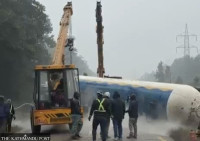National
Lipulekh, Limpiyadhura and Kalapani integral parts of Nepal, government says
Nepal government has been requesting Indian government to stop unilateral construction/expansion of any road that goes via Nepali territory, Minister Karki says.
Post Report
The Nepal government said on Sunday that Lipulekh is an integral part of Nepal.
“The government is firm and clear about the fact that the Lipulekh, Limpiyadhura and Kalapani region east of the Mahakali river is an integral part of Nepal,” said Ministry for Communications and Information Technology Gyanendra Bahadur Karki, also the government spokesperson. “The Nepal government has been requesting the Indian government to stop unilateral construction/expansion of any road that goes via Nepali territory.”
Karki was speaking to journalists to make public the Cabinet decisions.
“Nepal government is committed to resolving the border issues on the basis of historical treaties and agreements, facts, maps and evidence through diplomatic channels as per the spirit of friendly relations between the two countries,” said Karki.
The government position on Lipulekh comes a day after India issued a statement on the ongoing boundary row.
In a statement on Saturday, the Indian embassy in Kathmandu said: “The government of India’s position on the India-Nepal boundary is well known, consistent and unambiguous”.
“It has been communicated to the government of Nepal,” the embassy said.
The boundary row between Nepal and India vis-a-vis Lipulekh resurfaced after Indian Prime Minister Narendra Modi two weeks ago made a statement regarding road expansion via that region.
While addressing an election rally in Haldwani of Uttarakhand on December 30, Modi announced that his government had extended a road to Lipulekh and that there were more plans to extend it further.
Nepal’s political parties took umbrage at Modi’s statement, calling it uncalled for, and demanded that the Sher Bahadur Deuba government make a position and respond to India.
The main opposition CPN-UML criticised the government for failing to take the issue up with India, while calls grew within the ruling alliance also to send a note to India objecting to Modi’s statement.
On Friday, Gagan Thapa and Bishwa Prakash Sharma, two general secretaries of Deuba’s Nepali Congress, issued a statement demanding that the government take a position and asking India to stop road construction in Lipulekh.
The Kalapani region has remained an irritant in Nepal-India relations for decades.
Delhi’s publication of a new map of India in November 2019 placing the Kalapani region within the Indian territory had sparked protests in Nepal. Kathmandu sought diplomatic dialogue to resolve the issue, but Delhi cold-shouldered.
Just as things had calmed down, Indian Defence Minister Rajnath Singh inagurated the road link via Lipulekh in the first week of May 2020,
creating quite an uproar in Nepal. The Nepal government then on May 20, 2020 unveiled a new map incorporating Kalapani, Limpiyadhura and Lipulekh within the Nepali territory. The new map was endorsed by Parliament unanimously through a constitutional amendment.
India called the move “cartographic assertions.”
Nepal-India relations then hit a rock bottom. It took months for the two countries to bring the ties back to normal.
But Modi’s statement once again stoked concerns in Nepal.
India on Saturday said that all outstanding boundary issues will be resolved through the established mechanisms and channels.
“It is our view that the established inter-governmental mechanisms and channels are most appropriate for communication and dialogue,” said the embassy. “Mutually agreed boundary issues that are outstanding can always be addressed in the spirit of our close and friendly bilateral relations.”




 13.12°C Kathmandu
13.12°C Kathmandu












%20(1).jpg&w=300&height=200)

